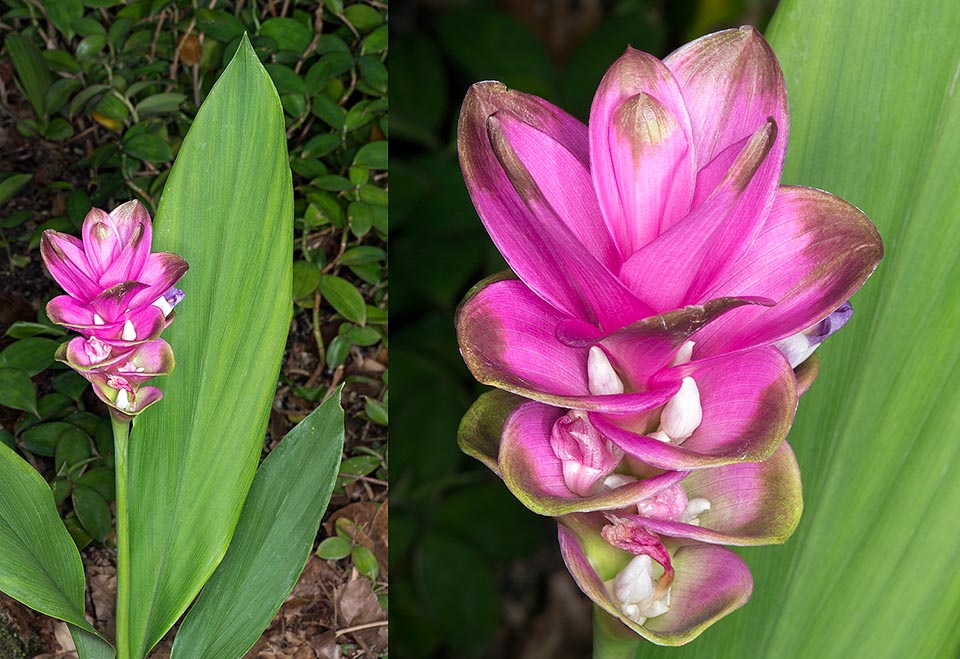Family : Zingiberaceae

Text © Pietro Puccio

English translation by Mario Beltramini
The species is native to Cambodia, Laos, Thailand and Vietnam where it grows in the open deciduous forests, open pine forests and swampy areas from the sea level up to about 1300 m of altitude.
The generic name comes from the Arabic “kurkum” = saffron, with reference to the saffron yellow colpour of the rhizome of the Curcuma longa L. (1753); the specific name is the combination of the name of the genus Alisma and of the Latin substantive “folium, ii” = leaf, with obvious reference.
Common names: ginger tulip, Siam tulip, summer tulip (English); açafrão-da-cochinchina (Portuguese-Brazil).
The Curcuma alismatifolia Gagnep. (1903) is a rhizomatous, perennial herbaceous species, deciduous, erect, 40-80 cm tall, with fusiform rhizome and lanceolate leaves, on long petiole, with pointed apex, 20-30 cm long and 2-5 cm broad, of intense green colour. The inflorescence, on an erect, 35-60 cm long peduncle, is a strobiliform spike, 10-15 cm long, formed by imbricate bracts spirally arranged, fleshy, the lower ones ovate of green colour, 2-3 cm long and broad, the upper ones obovate-lanceolate, 6-8 cm long and 1,5-4 cm broad, of pink to fuchsia colour, enclosing the flowers. Imbutiform calyx, about 1 cm long, corolla with about 1 cm long lobes, of white colour, one fertile stamen and labellum, 1,7-2,5 cm long and about 1,5 cm broad, of violet purple colour with yellow spot at the centre. The fruit is an ovoid capsule containing seeds provided of aril.

Native to Cambodia, Laos, Thailand and Vietnam, Curcuma alismatifolia is much cultivated in the tropics due to the showy inflorescences often used as cut flower © Giuseppe Mazza
Thanks to its attractive inflorescences, along with its numerous varieties of different colour, from white to purple, it is one of the most cultivated of the genus and stands at the centre of a flourishing trade, in particular in Thailand that is its greatest producer and exports all over the world the flowered plants as well as the cut inflorescences. Utilizable in the gardens of the tropical and humid subtropical climate zones in mass for impressive flower beds, requires filtered sun or partial shade and draining soils rich of organic substance, slightly acidic to neutral, maintained constantly humid during the vegetative period, but without stagnations. Elsewhere, the rhizomes may be taken off from the soil upon the first cold and conserved in the darkness in a cool location, aerated and dry, in peat or inert material, to be again interred in spring at a depth of 5-8 cm.
It is easily cultivated also in pot, in loam rich of humus with addition of siliceous sand per a 30%, placed in a very luminous location with regular waterings during the vegetative period, without ever allowing the substratum to dry up completely, high ambient humidity and monthly fertilizations with a hydrosoluble product for flower plants in pot. After blooming the leaves will begin to wither and will be cut when completely dry, the pot will be placed in an aerated ambient with lowest temperatures preferably not under the 16 °C, maintaining the loam just a little humid.
Synonyms: Hitcheniopsis alismatifolia (Gagnep.) Loes. (1930).
